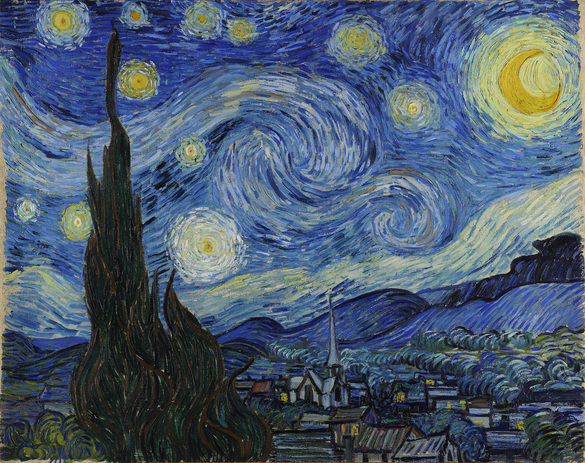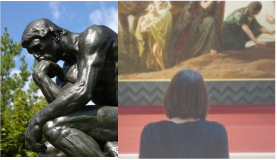Getting Started in GDES 120
Where do we start?
With a definition and a brief explanation.
GDES 120 Introduction to Digital Art is an art course that focuses on using digital tools to create visual
work. There is a heavy emphasis placed on developing critical thinking skills that allow students to
take advantage of different forms of visual communication that we explore throughout the duration of
the course.
What does this art course have to offer?
Any art course, graphic design, fine art based, etc. is about communication. So, what does Communication
mean exactly?
Communication is relating ideas to another person or group of people
Visual communication uses imagery to communicate ideas. Look at Van Gogh’s Starry Night. After looking at it,
what did it say/communicate to you? Perhaps look to your favorite movie, comic, or video game. How would
the ideas be represented without visuals? Would the characters or story have been the same?
With a definition and a brief explanation.
GDES 120 Introduction to Digital Art is an art course that focuses on using digital tools to create visual
work. There is a heavy emphasis placed on developing critical thinking skills that allow students to
take advantage of different forms of visual communication that we explore throughout the duration of
the course.
What does this art course have to offer?
Any art course, graphic design, fine art based, etc. is about communication. So, what does Communication
mean exactly?
Communication is relating ideas to another person or group of people
Visual communication uses imagery to communicate ideas. Look at Van Gogh’s Starry Night. After looking at it,
what did it say/communicate to you? Perhaps look to your favorite movie, comic, or video game. How would
the ideas be represented without visuals? Would the characters or story have been the same?
Communication isn’t sterile or static. It is constantly moving and constantly changing. It changes to best fit our
ideas. Learning the digital tools of Adobe Photoshop and Adobe Illustrator will present us with an enhanced set of
skills through which we can better communicate.
Why is this course relevant to me? /Why should I care?
Art is relevant. Think back to any PowerPoint presentation you have seen, what is usually the most interesting
part of any presentation?
Usually, if not always, it is when the information is present with or through a visual.
Visual communication is a powerful form of sharing ideas. Consider what the world would be like without
billboards, without any pictures on our food packaging, without logos from your favorite brands, or even, what if
all the cars were a single shade of gray, how would the world look? Better yet, how would that make you feel?
GDES 120 will give you a heightened perspective of what art is and how it fits into our everyday lives. Art is
everywhere and helps communicate something in every area of our lives.
What are some skills that I can take from this Class?
1. Improved communication skills that will allow you to not only better transfer ideas to someone else, but also
to better understand what is being presented to you. Whether you apply this skill in the classroom, to enhance
personal relationships, or apply it to how you approach a work situation, improving communication skills
enhances you abilities in any field from art to business to science.
2. Better visual presentations/illustrations also bolster our ability to better communicate. In a work situation,
where it is your jobs to relate information to your colleagues, your colleagues are not only more likely to pay
attention to a visual, but also, most often, will be better able to interpret the information if there is a visual aid.
Presentations need not always be confined to formal situations. When you go to buy something online, how
often do your purchase a product without being able to see an image to show you what it looks like? Not very
often. Presentations are just a directed form of communication. Being able to visually present or interpret an
idea is critical in almost every life situation.
3. Improved critical thinking skills. Making ideas that float around in our heads concrete and defined visually
breathes life into our inner worlds and thoughts. Learning this skill forces you to examine how you
communicate an idea in general, whether it starts written, drawn out, or doodled. As we build our skill sets we
will be able to translate complex ideas into a visual format.
Brainstorming to find an idea, further development to form that idea, and then cementing that idea, in this
case, in a visual format, truly brings ideas to life. Developing an idea and successfully communicating it is a
key critical thinking skill that can as easily be applied to a math class as it could a science or psychology class.
4. Better understanding of the world of art and what art means to you on a personal level is a crucial aspect of
this course as “Art” should not remain an abstract. Art encompasses so many folds of life, yet at its heart, art is
communication. Art can communicate exactly what we see, as in a photograph, or it can communicate a story
of another reality such as in a film, comic, or video game.
ideas. Learning the digital tools of Adobe Photoshop and Adobe Illustrator will present us with an enhanced set of
skills through which we can better communicate.
Why is this course relevant to me? /Why should I care?
Art is relevant. Think back to any PowerPoint presentation you have seen, what is usually the most interesting
part of any presentation?
Usually, if not always, it is when the information is present with or through a visual.
Visual communication is a powerful form of sharing ideas. Consider what the world would be like without
billboards, without any pictures on our food packaging, without logos from your favorite brands, or even, what if
all the cars were a single shade of gray, how would the world look? Better yet, how would that make you feel?
GDES 120 will give you a heightened perspective of what art is and how it fits into our everyday lives. Art is
everywhere and helps communicate something in every area of our lives.
What are some skills that I can take from this Class?
1. Improved communication skills that will allow you to not only better transfer ideas to someone else, but also
to better understand what is being presented to you. Whether you apply this skill in the classroom, to enhance
personal relationships, or apply it to how you approach a work situation, improving communication skills
enhances you abilities in any field from art to business to science.
2. Better visual presentations/illustrations also bolster our ability to better communicate. In a work situation,
where it is your jobs to relate information to your colleagues, your colleagues are not only more likely to pay
attention to a visual, but also, most often, will be better able to interpret the information if there is a visual aid.
Presentations need not always be confined to formal situations. When you go to buy something online, how
often do your purchase a product without being able to see an image to show you what it looks like? Not very
often. Presentations are just a directed form of communication. Being able to visually present or interpret an
idea is critical in almost every life situation.
3. Improved critical thinking skills. Making ideas that float around in our heads concrete and defined visually
breathes life into our inner worlds and thoughts. Learning this skill forces you to examine how you
communicate an idea in general, whether it starts written, drawn out, or doodled. As we build our skill sets we
will be able to translate complex ideas into a visual format.
Brainstorming to find an idea, further development to form that idea, and then cementing that idea, in this
case, in a visual format, truly brings ideas to life. Developing an idea and successfully communicating it is a
key critical thinking skill that can as easily be applied to a math class as it could a science or psychology class.
4. Better understanding of the world of art and what art means to you on a personal level is a crucial aspect of
this course as “Art” should not remain an abstract. Art encompasses so many folds of life, yet at its heart, art is
communication. Art can communicate exactly what we see, as in a photograph, or it can communicate a story
of another reality such as in a film, comic, or video game.
Creating A Welcome Page
The welcome page of your GDES 120 e-portfolio site is you chance to introduce yourself to your peers and visitors to your site. Your welcome page must be at least five sentences.
Consider stating who you are, your first name, and why you chose to take the GDES 120 Introduction to Digital Art class. Information you could include would be things such as: your hobbies, your job, who you are as a student, who you are in your family, what you like to do for fun, etc. If you know your major or the field you are thinking of entering career-wise, that would be something worth mentioning.
(Please remember that this is a public site. Therefore, information you do not want others to see should not be
posted anywhere on this site)
See the What Not to Put in An E-Portfolio Page for more details.
The idea with the welcome page is to paint a picture, briefly, of who you are.
Example student welcome page:
My name is Alex. This is my first semester at Montgomery College. I am not really sure what to say or where to
start really. I took a few years off after high school and thought I would follow an interest of mine, which ended
up not working out.
I enjoy doodling and creating characters, so I thought an art class would allow me to see if I could develop my
skills and determine whether or not I will pursue art in the future.
I hope that by the end of the semester I will have a set of skills that will allow me, at the least to draw better, or
perhaps find that I will pursue art.
The welcome page of your GDES 120 e-portfolio site is you chance to introduce yourself to your peers and visitors to your site. Your welcome page must be at least five sentences.
Consider stating who you are, your first name, and why you chose to take the GDES 120 Introduction to Digital Art class. Information you could include would be things such as: your hobbies, your job, who you are as a student, who you are in your family, what you like to do for fun, etc. If you know your major or the field you are thinking of entering career-wise, that would be something worth mentioning.
(Please remember that this is a public site. Therefore, information you do not want others to see should not be
posted anywhere on this site)
See the What Not to Put in An E-Portfolio Page for more details.
The idea with the welcome page is to paint a picture, briefly, of who you are.
Example student welcome page:
My name is Alex. This is my first semester at Montgomery College. I am not really sure what to say or where to
start really. I took a few years off after high school and thought I would follow an interest of mine, which ended
up not working out.
I enjoy doodling and creating characters, so I thought an art class would allow me to see if I could develop my
skills and determine whether or not I will pursue art in the future.
I hope that by the end of the semester I will have a set of skills that will allow me, at the least to draw better, or
perhaps find that I will pursue art.
Be sure to check out the link for what not to put on your e-portfolio site ---->
|







